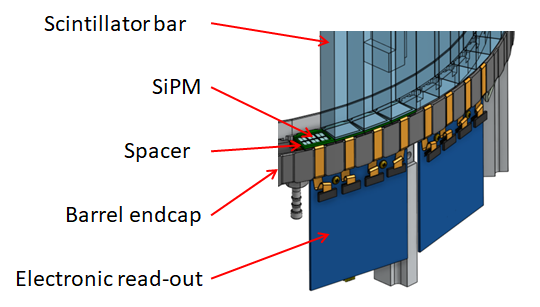Barrel Scintillator
Back to Main Page
Table of Figures
Purpose
Antihydrogen annihilation identification in ALPHA crucially depends on the software capability to reject background events, i.e., cosmic rays. Given that the ALPHA-g detectors offer more information than what was available in ALPHA, new and more sophisticated algorithms will be developed to remove backgrounds events. Two types of tools will be deployed: “online” software aimed to monitor antihydrogen production and “machine learning algorithms” to eliminate background from the physics measurements.
While this software will provide the necessary rejection of the cosmic rays, the information collected for making this decision is based on a "Barrel Scintillator" layer surrounding the Radial TPC. Particles traversing this detector will leave a track of light which is recorded in time and intensity. The time correlation between different parts of the Barrel Scint. will permit the identification of the source of the particle.
Scope
Design of the Barrel Scintillator
The barrel scintillator is constituted of 64 scintillators bars and forms a barrel which surround the TPC. The following picture present the design of this barrel.
This cylinder is literally a barrel due to the fact that each bar has a trapezoidal section. This reinforce naturally the structural resistance and stability of the cylinder. The amount of bar (64) is a compromised between the acceptable quantity of data, and the azimuth (φ) resolution. The length of each bar is 2.6 meter which is enough to cover the whole 2.4 meter TPC.
Light collection
The scintillators bars are made from EJ200 plastic scintillator from the Texan company Eljen Technology ([Eljen2016]). A particle crossing this scintillator will produce light whose the wavelength is centered around 425 nm. This light is emitted in all direction and reach the Silicone PhotoMultiplier(SiPM) applied on each side of each bar. The silicone Photomultipliers are the 6x6mm MicroFJ-60035 from the company SensL ([SensL2015]). The wavelength of the photon Detection Efficiency peak for these sensors is 420 nm, which correspond to the light emitted by the scintillator. Furthermore these sensors are bias with a low voltage (-30V) and have a small thickness (about 1mm) which make easier their integration in the read-out of the barrel scintillator.
Between the edge of the scintillator bar and the SiPM, a thin thickness (about 1-2 mm) of a transparent silicone rubber have been add in order to prevent any air gap. This silicone rubber is the RTV 615 product with 5% of hardener (by mass) which is commonly used to couple the photo-multipliers tubes to light guides. Previous tests have shown an increase of 30% in the light transmitted to the SiPM with this silicone rubber, in comparison with a set-up without any coupling material. 6 SiPMs are used for the read-out of the light of each edge of the bars. This means approximately 50% of the edge is covered by SiPM. This choice is a compromised between the space constraints (enough space have to be kept to support the weight of each bar), and the fact that the more the light is receive, the better the time resolution is.
Electronic read-out
Definitions and Abbreviations
General acronyms or terms used for the ALPHA-g experiment
| rTPC | Radial Time projection Chamber |
| z | Coordinate along the main axis of the trap and rTPC |
| φ | Azimuthal coordinate, φ = 0 is in direction of cartesian x |
| θ | Angle towards the z-axis |
| r | Radial coordinate in the cylindrical rTPC system |
| pφ | φ component of the pion's original momentum |
| pθ | θ component of the pion's original momentum |
| GEANT4 | GEometry ANd Tracking, particle physics simulation package |
| Garfield++ | Gas detector simulation package |
Table 1 – ALPHA-g Abbreviations
References and Related Documents
links Sensl
Studies
Timing resolution
Amplitude correction
Mechanical structure
Description dwg, assembly
